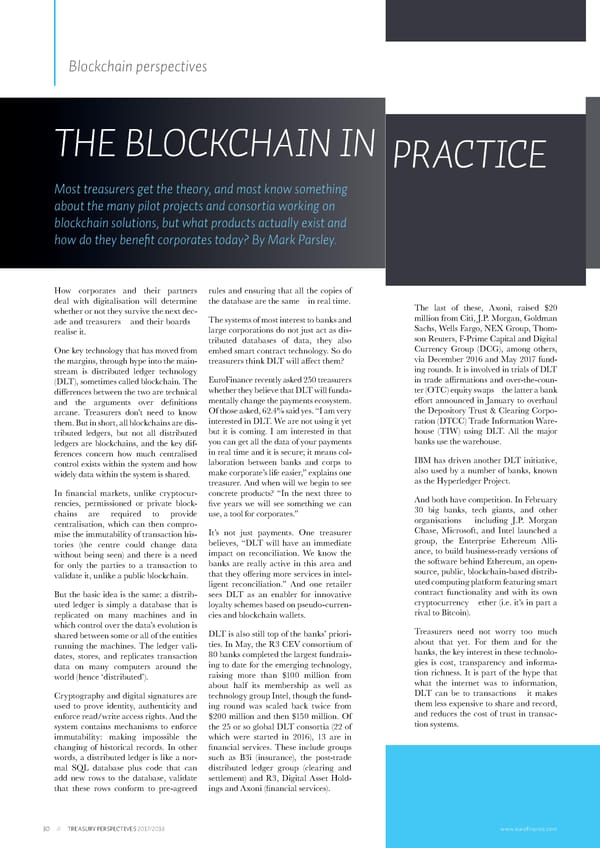Blockchain perspectives THE BLOCKCHAIN IN PRACTICE Most treasurers get the theory, and most know something about the many pilot projects and consortia working on blockchain solutions, but what products actually exist and how do they benefit corporates today? By Mark Parsley. How corporates and their partners rules and ensuring that all the copies of deal with digitalisation will determine the database are the same – in real time. The last of these, Axoni, raised $20 whether or not they survive the next dec- million from Citi, J.P. Morgan, Goldman ade and treasurers – and their boards – The systems of most interest to banks and realise it. large corporations do not just act as dis- Sachs, Wells Fargo, NEX Group, Thom- tributed databases of data, they also son Reuters, F-Prime Capital and Digital One key technology that has moved from embed smart contract technology. So do Currency Group (DCG), among others, the margins, through hype into the main- treasurers think DLT will affect them? via December 2016 and May 2017 fund- stream is distributed ledger technology ing rounds. It is involved in trials of DLT (DLT), sometimes called blockchain. The EuroFinance recently asked 250 treasurers in trade affirmations and over-the-coun- differences between the two are technical whether they believe that DLT will funda- ter (OTC) equity swaps – the latter a bank and the arguments over definitions mentally change the payments ecosystem. effort announced in January to overhaul arcane. Treasurers don’t need to know Of those asked, 62.4% said yes. “I am very the Depository Trust & Clearing Corpo- them. But in short, all blockchains are dis- interested in DLT. We are not using it yet ration (DTCC) Trade Information Ware- tributed ledgers, but not all distributed but it is coming. I am interested in that house (TIW) using DLT. All the major ledgers are blockchains, and the key dif- you can get all the data of your payments banks use the warehouse. ferences concern how much centralised in real time and it is secure; it means col- IBM has driven another DLT initiative, control exists within the system and how laboration between banks and corps to also used by a number of banks, known widely data within the system is shared. make corporate’s life easier,” explains one as the Hyperledger Project. treasurer. And when will we begin to see In financial markets, unlike cryptocur- concrete products? “In the next three to And both have competition. In February rencies, permissioned or private block- five years we will see something we can 30 big banks, tech giants, and other chains are required to provide use, a tool for corporates.” organisations – including J.P. Morgan centralisation, which can then compro- Chase, Microsoft, and Intel launched a mise the immutability of transaction his- It’s not just payments. One treasurer group, the Enterprise Ethereum Alli- tories (the centre could change data believes, “DLT will have an immediate ance, to build business-ready versions of without being seen) and there is a need impact on reconciliation. We know the the software behind Ethereum, an open- for only the parties to a transaction to banks are really active in this area and source, public, blockchain-based distrib- validate it, unlike a public blockchain. that they offering more services in intel- uted computing platform featuring smart ligent reconciliation.” And one retailer contract functionality and with its own But the basic idea is the same: a distrib- sees DLT as an enabler for innovative cryptocurrency – ether (i.e. it’s in part a uted ledger is simply a database that is loyalty schemes based on pseudo-curren- rival to Bitcoin). replicated on many machines and in cies and blockchain wallets. which control over the data’s evolution is Treasurers need not worry too much shared between some or all of the entities DLT is also still top of the banks’ priori- about that yet. For them and for the running the machines. The ledger vali- ties. In May, the R3 CEV consortium of banks, the key interest in these technolo- dates, stores, and replicates transaction 80 banks completed the largest fundrais- gies is cost, transparency and informa- data on many computers around the ing to date for the emerging technology, tion richness. It is part of the hype that world (hence ‘distributed’). raising more than $100 million from what the internet was to information, about half its membership as well as DLT can be to transactions – it makes Cryptography and digital signatures are technology group Intel, though the fund- them less expensive to share and record, used to prove identity, authenticity and ing round was scaled back twice from and reduces the cost of trust in transac- enforce read/write access rights. And the $200 million and then $150 million. Of tion systems. system contains mechanisms to enforce the 25 or so global DLT consortia (22 of immutability: making impossible the which were started in 2016), 13 are in changing of historical records. In other financial services. These include groups words, a distributed ledger is like a nor- such as B3i (insurance), the post-trade mal SQL database plus code that can distributed ledger group (clearing and add new rows to the database, validate settlement) and R3, Digital Asset Hold- that these rows conform to pre-agreed ings and Axoni (financial services). 30 // TREASURY PERSPECTIVES 2017/2018 www.eurofinance.com
 Who's Running the Treasury? Page 29 Page 31
Who's Running the Treasury? Page 29 Page 31